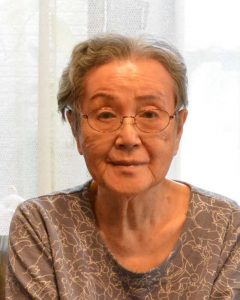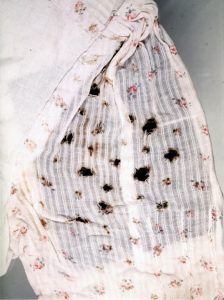Documenting Hiroshima of 1945: In November, study of thermal rays focuses on color of clothing
Nov. 29, 2024
by Kyosuke Mizukawa, Senior Staff Writer
In November 1945, Lieutenant Colonel Averill Liebow, a U.S. military physician who was stationed in Hiroshima City as a member of a joint Japan-U.S. survey team, collected clothing worn by citizens at the time of the atomic bombing to investigate the effects of the bombing’s thermal rays, with a focus on the specific way the clothes had been burned.
On November 10, Mr. Liebow recorded particularly noteworthy items using color photographs. One of the items was a short-sleeved blouse showing differences in color-dependent heat absorption, with its white fabric left unburned but its rose patterns burned away. According to his book titled Encounter With Disaster: A Medical Diary of Hiroshima, 1945, published in 1965, the areas with the crimson, rose-petal patterns had absorbed the heat.
Four photos of the blouse remain, with one having been labeled “SHIBATA.” The blouse was made by Shizue Yamamoto (née Shibata), who is now 100 years old and living in the town of Oiso in Kanagawa Prefecture, from fabric sent to her by her mother, who was living in the United States. Shizue had been wearing the blouse when she experienced the bombing at the age of 21.
Her grandfather had emigrated from Hiroshima to the United States, and Shizue was born in Los Angeles in 1924. Because her mother was extremely busy with her work of managing an inn, Shizue returned to Japan with her grandfather when she was around two years old, and lived with relatives in the area of Shinonome-cho (in Hiroshima’s present-day Minami Ward).
On August 6, on her way to work at a munitions factory near Yokogawa Station (in Hiroshima’s present-day Nishi Ward), Shizue was suddenly engulfed in light at a location in front of Hiroshima Station, around 1.8 kilometers northeast of the hypocenter. She thought that “the electric wires for the trains had short-circuited.” Her left arm, which was directly exposed to the thermal rays, suffered severe burns not only on her exposed forearm but also on the skin underneath the burned-out floral patterns.
She also suffered burns on her legs, which made it difficult for her to stand, and after a while, she lost her hair. “It took about three months before my wounds and symptoms healed,” she said. While bedridden, she had been asked to hand over her clothes, but she said she does not remember exactly what happened to them. Her burn scars developed into keloids, which made it difficult for her to freely bend her left arm.
Mr. Liebow wrote in his book that he had brought back Shizue’s clothing with him when he returned to the United States the following year. Some of the pathology specimens and other materials that had been sent to the United States were returned to Japan after the occupation ended. However, there is no record of Shizue’s blouse being returned, with its whereabouts still unknown.
(Originally published on November 29, 2024)
In November 1945, Lieutenant Colonel Averill Liebow, a U.S. military physician who was stationed in Hiroshima City as a member of a joint Japan-U.S. survey team, collected clothing worn by citizens at the time of the atomic bombing to investigate the effects of the bombing’s thermal rays, with a focus on the specific way the clothes had been burned.
On November 10, Mr. Liebow recorded particularly noteworthy items using color photographs. One of the items was a short-sleeved blouse showing differences in color-dependent heat absorption, with its white fabric left unburned but its rose patterns burned away. According to his book titled Encounter With Disaster: A Medical Diary of Hiroshima, 1945, published in 1965, the areas with the crimson, rose-petal patterns had absorbed the heat.
Four photos of the blouse remain, with one having been labeled “SHIBATA.” The blouse was made by Shizue Yamamoto (née Shibata), who is now 100 years old and living in the town of Oiso in Kanagawa Prefecture, from fabric sent to her by her mother, who was living in the United States. Shizue had been wearing the blouse when she experienced the bombing at the age of 21.
Her grandfather had emigrated from Hiroshima to the United States, and Shizue was born in Los Angeles in 1924. Because her mother was extremely busy with her work of managing an inn, Shizue returned to Japan with her grandfather when she was around two years old, and lived with relatives in the area of Shinonome-cho (in Hiroshima’s present-day Minami Ward).
On August 6, on her way to work at a munitions factory near Yokogawa Station (in Hiroshima’s present-day Nishi Ward), Shizue was suddenly engulfed in light at a location in front of Hiroshima Station, around 1.8 kilometers northeast of the hypocenter. She thought that “the electric wires for the trains had short-circuited.” Her left arm, which was directly exposed to the thermal rays, suffered severe burns not only on her exposed forearm but also on the skin underneath the burned-out floral patterns.
She also suffered burns on her legs, which made it difficult for her to stand, and after a while, she lost her hair. “It took about three months before my wounds and symptoms healed,” she said. While bedridden, she had been asked to hand over her clothes, but she said she does not remember exactly what happened to them. Her burn scars developed into keloids, which made it difficult for her to freely bend her left arm.
Mr. Liebow wrote in his book that he had brought back Shizue’s clothing with him when he returned to the United States the following year. Some of the pathology specimens and other materials that had been sent to the United States were returned to Japan after the occupation ended. However, there is no record of Shizue’s blouse being returned, with its whereabouts still unknown.
(Originally published on November 29, 2024)









